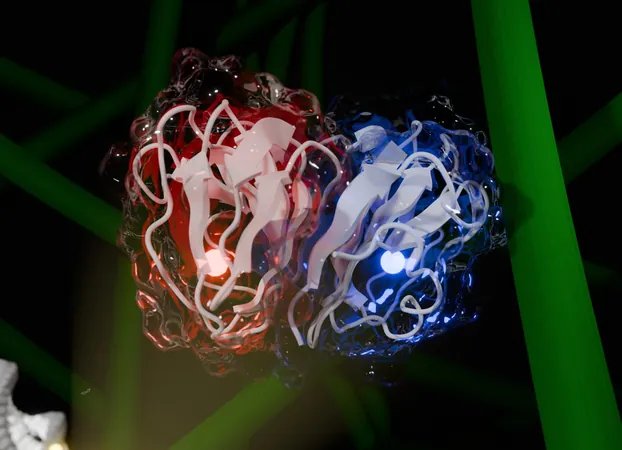
This Revolutionary Enzyme Could Transform Biofuel Manufacturing!
2025-05-09
Author: Arjun
Unleashing the Power of Cellulose in Biofuels
The journey from biomass to biofuel hinges on one crucial player: cellulose. Being the planet’s most abundant renewable polymer, cellulose is an incredibly tough nut to crack, resisting biological breakdown like no other. Even though it's made solely of glucose, its tightly packed structure paired with lignin and hemicelluloses creates major obstacles for degradation.
For decades, researchers have tried to unlock the secrets of cellulose to amplify ethanol production, particularly from sugarcane. But now, a groundbreaking discovery from the Brazilian Center for Research in Energy and Materials (CNPEM), in collaboration with experts worldwide, could be the game-changer we've been looking for!
Meet CelOCE: The Enzyme That Could Change Everything
Introducing the revolutionary enzyme, CelOCE (Cellulose Oxidative Cleaving Enzyme). This remarkable find could supercharge the large-scale production of second-generation ethanol from agricultural waste like sugarcane bagasse and corn straw. Published in the prestigious journal Nature, this discovery could reshape how we think about biofuel production.
According to Mário Murakami, head of CNPEM's biocatalysis team, "We've identified a metalloenzyme that enhances cellulose conversion through a previously unknown mechanism of substrate binding and oxidative cleavage." With this breakthrough, we’re not just looking at small enhancements; we’re talking about a major leap in redox biochemistry for breaking down biomass!
A Paradigm Shift in Biofuel Technology
Historically, the addition of monooxygenases to the enzyme mix marked the first revolution in cellulose deconstruction. For the first time, researchers used redox biochemistry to tackle cellulose’s stubbornness. However, CelOCE breaks that paradigm wide open! This isn’t just an incremental change; researchers found that adding CelOCE doubles the efficiency compared to traditional monooxygenases.
Murakami explains, "If we add a monooxygenase, we get a 1X increase; add CelOCE, and we achieve 2X! Nature has provided us with a new and even more effective strategy to tackle the cellulose conundrum.”
How CelOCE Works Its Magic
So, how does CelOCE do it? This enzyme attaches itself to the end of cellulose fibers and cleaves them, loosening the crystalline structure. This process makes cellulose more accessible for other enzymes to convert it into sugar. CelOCE operates like a master key, unlocking the cellulose locks that classical enzymes couldn’t touch.
Furthermore, this metalloenzyme is self-sufficient; it generates its own peroxide from within, eliminating the need for an external source during industrial processes. This self-contained powerhouse could revolutionize how we produce biofuels at scale.
From Lab to Real-World Application
This discovery didn't come easy. Researchers delved into soil samples enriched with sugarcane bagasse, employing advanced techniques like metagenomics, proteomics, and genetic engineering. After an extensive exploration and experimentation, CelOCE emerged as a viable solution ready for pilot-scale deployment.
Murakami emphasizes that CelOCE is not just a theoretical solution waiting for validation; it’s proven to be implementable right away. Given Brazil’s leadership in biofuel production and the global push for sustainable energy solutions, this enzyme could not only reshape Brazil’s biofuel landscape but also influence initiatives worldwide.
The Future of Biofuels is Bright!
With current cellulose degradation efficiencies ranging from 60% to 80%, optimizing this process is crucial. A breakthrough like CelOCE means converting significantly more biomass waste into usable fuel, paving the way for eco-friendly biofuels, including aviation fuel. Murakami concludes, "Every fraction of efficiency gains translates to transformative changes in how we utilize waste. We're on the verge of a biofuel revolution, and CelOCE is leading the charge!"




 Brasil (PT)
Brasil (PT)
 Canada (EN)
Canada (EN)
 Chile (ES)
Chile (ES)
 Česko (CS)
Česko (CS)
 대한민국 (KO)
대한민국 (KO)
 España (ES)
España (ES)
 France (FR)
France (FR)
 Hong Kong (EN)
Hong Kong (EN)
 Italia (IT)
Italia (IT)
 日本 (JA)
日本 (JA)
 Magyarország (HU)
Magyarország (HU)
 Norge (NO)
Norge (NO)
 Polska (PL)
Polska (PL)
 Schweiz (DE)
Schweiz (DE)
 Singapore (EN)
Singapore (EN)
 Sverige (SV)
Sverige (SV)
 Suomi (FI)
Suomi (FI)
 Türkiye (TR)
Türkiye (TR)
 الإمارات العربية المتحدة (AR)
الإمارات العربية المتحدة (AR)